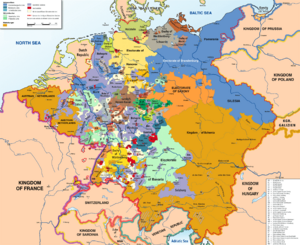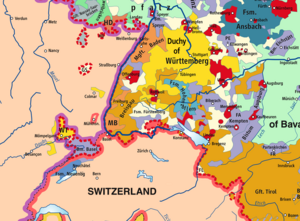Battle of Rastatt (1796) facts for kids
Quick facts for kids Battle of Rastatt |
|||||||
|---|---|---|---|---|---|---|---|
| Part of French Revolutionary Wars | |||||||
|
|||||||
| Belligerents | |||||||
| Commanders and leaders | |||||||
| Units involved | |||||||
| Strength | |||||||
| 20,500 | 6,000 | ||||||
| Casualties and losses | |||||||
| unknown | 200, 3 guns | ||||||
The Battle of Rastatt happened on July 5, 1796. It was a fight during the French Revolutionary Wars. A part of the French army, led by General Jean Victor Marie Moreau, fought against the Austrian army. The Austrians were defending the Murg River line.
General Louis Desaix, leading a part of Moreau's army, attacked the Austrians. He pushed them back to the Alb River. This battle was part of the War of the First Coalition. Rastatt is a city in Germany, located in the state of Baden-Württemberg. It's about 89 kilometers (55 miles) south of Mannheim.
In the Rhine Campaign of 1796, Moreau's army successfully crossed the Rhine River at Kehl. This happened on June 24. Moreau then made his army's position stronger. He sent Desaix north, Laurent Gouvion Saint-Cyr east, and Pierre Marie Barthélemy Ferino south. The French won a smaller fight against Anton Sztáray at Renchen on June 28. After that, they moved to attack Latour at Rastatt. Soon, Archduke Charles, Duke of Teschen joined Latour with more soldiers. The Battle of Ettlingen on July 9 would decide if Moreau could continue his invasion into Germany.
Contents
Why the Battle of Rastatt Happened
The Battle of Rastatt was part of a bigger conflict. This was the French Revolutionary Wars. These wars involved France and many other European countries. They wanted to stop the French Revolution.
The Rhine River and Its Surroundings
The Rhine River was a very important natural border. It flowed between the German states and Switzerland. In the 1790s, the river was wide and wild. It had many channels and islands. Crossing it was very difficult. There were only a few reliable places to cross. Two important crossing points were at Kehl and Hüningen.
The land around the Rhine was a wide plain. It had many villages and farms. On the eastern side, the Black Forest mountains created deep valleys. Small rivers from these mountains flowed into the Rhine.
The Holy Roman Empire's Many States
The German-speaking lands on the east bank of the Rhine were part of the Holy Roman Empire. This was a huge collection of territories. It had over 1,000 different states! These states varied greatly in size. Some were tiny, just a few square miles. Others were larger, like the Kingdom of Bavaria or Prussia.
These states were governed in different ways. Some were free cities, like Augsburg. Others were church lands, like the Archbishopric of Cologne. Many were ruled by noble families. Looking at a map, the Empire looked like a "patchwork carpet." This made it hard for the different parts to work together.
Armies Ready for Battle
The armies fighting against France were called the First Coalition. They had about 125,000 soldiers. Archduke Charles, Duke of Teschen was their main commander. His troops stretched from Switzerland to the North Sea. Most of his army were Habsburg soldiers. But they were spread out over a very long front.
Charles placed most of his soldiers, led by Count Latour, between Karlsruhe and Darmstadt. This area was important because the Rhine and Main rivers met there. It was a likely place for a French attack. Some local militias, mostly untrained, joined the Austrian forces. Charles didn't like to use these militias in important places. So, he put about 7,000 of them at the Kehl crossing.
French Battle Plans
The French leaders believed they had to invade the German states. They thought war should pay for itself. The French army needed to get supplies and money from the lands they occupied. The French soldiers were often unpaid. This sometimes led to soldiers refusing to follow orders.
The French faced a strong enemy. The Coalition's Army of the Lower Rhine had 90,000 soldiers. Another 80,000 soldiers were in the Army of the Upper Rhine. At first, the Austrians wanted to attack the French armies one by one. But then, news came about Napoleon Bonaparte's victories in Italy. So, 25,000 Austrian soldiers were sent to Italy. Archduke Charles was then put in charge of both Austrian armies. He was told to hold his ground.
The French had two main armies. Jean-Baptiste Jourdan's army had 80,000 men. They were on the west bank of the Rhine. Jean Victor Moreau commanded the Army of the Rhine and Moselle. His army was positioned along the Rhine.
The French plan was for Jourdan's army to push south. This would draw the enemy's attention. Then, Moreau's army would cross the Rhine more easily. If the plan worked, Jourdan would pretend to attack Mannheim. This would make Charles move his soldiers north. Then, Moreau's army would quickly move to Strasbourg. From there, they would cross the river at Kehl. This crossing was guarded by the less experienced Swabian militia. In the south, near Basel, General Pierre Marie Barthélemy Ferino would cross the river. He would advance along the Rhine towards Lake Constance. This plan aimed to surround and trap Charles's army.
The Battle of Rastatt
First Moves
Archduke Charles moved most of his soldiers to the middle and northern Rhine. He thought the French would attack there. This left only the Swabian militia at the Kehl-Strasbourg crossing. A smaller force, led by Karl Aloys zu Fürstenberg, was at Rastatt. There was also a small group of French royalists.
But Moreau surprised Charles. He quickly marched most of his army to Strasbourg. He even left his heavy cannons behind to move faster. On June 20, Moreau's lead soldiers attacked the enemy posts near Strasbourg. They pushed the militia back to Kehl. The militia left their cannons behind, which helped Moreau.
On the same day, General Ferino crossed the Rhine near Basel. He moved east along the German side of the river without being stopped. This created a "pincer" effect. Jourdan's army was coming from the north. Moreau's main army was crossing in the center. And Ferino's force was crossing in the south.
Within a day, Moreau had four divisions across the river. This was a big success for the French plan. Ferino chased the enemy towards Villingen. Meanwhile, General Laurent Gouvion Saint-Cyr pushed the local troops into Rastatt. Latour and Sztáray tried to hold the Murg River line. The French had about 19,000 foot soldiers and 1,500 horsemen. The Austrians had 6,000 men. The French captured 200 Austrian soldiers and three cannons.
The Main Fight
On July 5, 1796, General Desaix's troops reached Latour's forces at Rastatt.
What Happened Next
Desaix attacked Latour's army from both sides. He pushed the Austrian and Imperial forces back to the Alb River. The Austrians didn't have enough soldiers to stop Moreau's army. They needed more help from Charles. But Charles was busy in the north, keeping Jourdan's army on the west bank of the Rhine.
Charles realized he needed to send more soldiers. He was worried that Moreau's surprise crossings at Kehl and Hüningen would surround his army. So, Charles arrived near Rastatt with extra troops. He planned to attack Moreau on July 10. But the French attacked first, on July 9.
In the Battle of Ettlingen, Charles managed to push back Desaix's attacks. But Saint-Cyr and Taponier gained ground in the hills. They threatened Charles's side. Moreau lost 2,400 soldiers, while Charles lost 2,600. Even though the losses were similar, Charles was worried about his supply lines. So, he began a careful retreat to the east.
Armies in the Battle
French Army
- Commander: Louis Desaix
- Divisions led by:
- Antoine Guillaume Delmas (with infantry and hussars)
- Michel de Beaupuy (with infantry and chasseurs)
- Charles Antoine Xaintrailles (with infantry and carabiniers)
Austrian and Coalition Army
- The Swabian Circle Contingent included:
- Infantry Regiments from Württemberg, Baden-Durlach, Fugger, and Wolfegg.
- Cavalry units like Hohenzollern Royal and Imperial Cavalry and Württemberg Dragoons.
- Two field artillery battalions.
Images for kids






